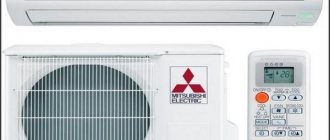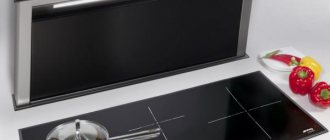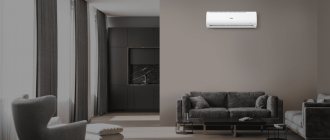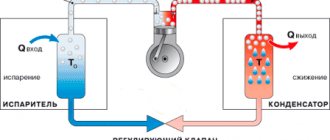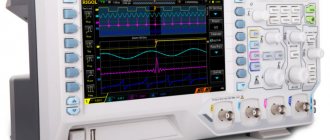It probably happened historically that when considering air conditioners, many experienced buyers first get acquainted with new products from well-known Japanese manufacturers. It is worth noting right away that many worthy competitors have recently appeared on the market, although in the premium class not many Chinese and Taiwanese analogues are able to “beat” them. As for the entry-level and mid-budget classes, the picture is somewhat different. However, in our rating of the best split systems of 2022, everyone will be able to find a suitable model for their “wallet”. At the same time, the editorial staff tried to pay attention to the main questions of buyers and collected models to meet the needs of different users. In our list you will find:
- budget split systems for small rooms;
- advanced conditioners for allergy sufferers;
- popular models in price/quality ratio;
- premium equipment for servicing large houses.
What is a split system, where is it used and what does it consist of?
Generally speaking, a split system is one of the types of air conditioners that is most convenient to use and is in greatest demand.
The device is especially relevant in houses where central air conditioning is not provided.
The advantages of a split system include efficiency and low noise levels (especially in comparison with monoblocks). Such advantages were achieved by dividing the equipment into two blocks - internal and external.
The external part is equipped with a condenser, compressor and fan. The block is installed on the external part of the structure (on the roof, on the wall or balcony). The noise level of this unit is about 50-60 dB.
The second part (indoor unit) contains a fan and an evaporator, and the installation is carried out inside a refrigerated room. Here the noise level is lower - 25-30 dB.
Thanks to this feature, the sound from the air conditioner was reduced by almost a thousand times. So it is not surprising that such systems have become widespread in all residential premises - in apartments, houses, offices and other buildings.
Standard formulas for calculating suitable power
To calculate the total power of a fusion system, the indicators of the main factors are added up:
An indicator of heat gain, depending on the area of the room, ceiling height and number of windows. To do this, calculate: area*ceiling height*illuminance factor/1000. The illumination factor is selected as follows: 30 for darkened rooms, 35 for moderately lit rooms, 40 for strongly lit rooms.- An indicator of heat release from human bodies. 0.1 kW for each person, if there is no need to engage in physical activity in this room.
- Heat inflows from household appliances. The average figure is calculated at 30% of the power consumed by the device. For example, a computer with a power of 0.9 kW allocates 0.3 kW, etc.
After adding up all the indicators, the average power required by the air conditioner in a particular room is obtained.
Types of split systems
What determines their choice, pros and cons, which of them are most common and popular. As noted above, the device consists of two separate blocks - internal and external.
Both elements are connected to each other using copper tubes and electrical cables. The main differences concern the device mounted indoors.
Here are the following options for split systems:
- Wall-mounted.
- Floor-standing.
- Ceiling-mounted.
- Duct.
- Cassette.
- Floor-ceiling.
Before choosing a split system, it is worth understanding the features of its placement. Each type of device is designed for a specific room. For example, wall-mounted split systems are more suitable for apartments and private houses. This type of device is household.
As for other types of products, they fall into the commercial category.
Their peculiarity lies in their ability to serve rooms where there are a large number of people.
Despite their greater efficiency, there is no point in installing commercial air conditioners in ordinary apartments with a small area.
This is due to the fact that it will not be possible to fully use the capabilities of such models, but you will have to overpay for using the split system.
Some experts do not agree with this opinion. They assure that duct and cassette air conditioners, as well as floor and ceiling split systems can be used in a private home.
The main thing is that the selection and installation is carried out by a professional. The peculiarity of duct and cassette split systems is that they require a large ceiling space.
They do an excellent job of air-conditioning rooms with high ceilings or unusual geometric shapes.
In addition, complex systems are more economical compared to classical devices.
Duct air conditioners
Some experts claim that the best solution is ducted air conditioners.
Their advantages:
- Compactness. Such devices take up minimal space and can be installed in a hallway or utility room;
- You can do without installing an indoor unit. Instead, special grilles are installed in the room, which can be easily matched to any interior;
- With one unit you can cool and ventilate several rooms at once;
- Ensures uniform distribution of air in a room of any shape, including irregular ones.
But there is one difficulty. To install and configure such a split system in an apartment or house, you must invite a specialist who will wisely approach the placement of air ducts, the indoor unit, and also quickly resolve any problems that arise.
A ducted air conditioner guarantees that the average temperature is achieved for all rooms, and individual control becomes unavailable. In addition, due to the presence of channels, odors can be transferred between rooms.
Cassette air conditioner
If the room has a high ceiling, the best solution is a cassette air conditioner.
Its advantages lie in its ability to evenly distribute and renew the air in the room. But here, as in the previous case, you cannot do without a ceiling space - from 20 cm or more.
For channel devices, this figure is from 25 cm. It must be remembered that channel and cassette systems are important not only to choose correctly, but also to install taking into account existing rules.
This is due to the fact that the air and freon pipelines are behind the beautiful finish.
If the system fails, cost savings on installation may require more expensive and time-consuming repairs and restoration. When choosing, it is important to take into account not only the type, but also the power of the split system and its performance.
On average, 10 square meters of space requires 1 kW of power. This requirement is relevant for standard ceiling height (2.5 m). It is also worth considering the glass area, the number of people in the room, the presence of equipment and other heat sources.
That’s why you should turn to professionals in your field for help in choosing and installing. A good option is split systems with an air ionizer. Their peculiarity lies in the additional purification of the air, as well as its saturation with ions, which have a positive effect on well-being.
Such devices are often installed in children's rooms of private houses or apartments. An interesting option are air conditioners made using Mega Ion+Patrol Sensor technology. E
This is a Japanese development, the essence of which is the generation of negative ions with the OH group.
The latter removes harmful bacteria from the air and deactivates existing viruses. In addition, the overall efficiency of such split systems is 40-50 percent higher.
What are the operating modes of air conditioners?
Most air conditioners are manufactured abroad, so the mode designations on the remote control are often in English. One of the exceptions is Haier devices: their menus are Russified (full catalog here). You can find the following designations:
- Cold (cooling, snowflake symbol) - starts the compressor, which cools the air. Once the temperature reaches the specified value, the fan will slow down and operate at lower speeds.
- Heat (heating, symbol of the sun) - the evaporator and condenser change roles and begin to heat the air in the room.
- Dry (drying, drop symbol) - in this mode, the temperature on the surface of the evaporator is reduced as much as possible, the fan starts working at low speeds and blows on the evaporator. This leads to condensation of moisture, which is discharged outside. A good solution for regions with high humidity.
- Fan Speed (fan symbol) - adjusts the rotation speed of the indoor unit fan.
- Sleep (night mode, symbol of the month) - noise reduction to 18–19 dB(A) at night.
- Timer (timer, dial symbol) - the ability to set automatic on and off (including interval) and mode changes.
- Swing (air dispersion) - changes the position of the air conditioner curtains, allows you to direct the flow in any direction or enable fan distribution.
- Lock (lock, lock symbol) - locks the remote control from children or accidental pressing.
Design
Each component of the split system has individual structural elements. The external unit contains:
- A compressor is a device that compresses freon and maintains its movement through the refrigeration circuit. It can be spiral or piston. Spiral products are more reliable, but they are more expensive than their piston “brothers”.
- 4-way valve. This part is mounted in reversible air conditioners. The task of the device is to change the direction of movement of freon through the system, which leads to a change in the function of the blocks. The external unit works for heating, and the internal one for cooling.
- The control board is an element characteristic of converter-type split systems. Other types of devices place the electronics on the indoor unit due to the risk of damage due to high humidity and temperature.
- Condenser is a unit in which freon is cooled and condensed. The air that passes through the air conditioner warms up.
- A fan is a device that provides air flow. Cheaper models have only one speed, which means the air conditioner can operate within a small temperature range. In more expensive devices, fans have 2-3 speeds, which significantly expands the functionality of the split system.
- The freon unit filter is a device that is placed in front of the compressor inlet and protects it from foreign elements. If the installation was carried out in violation of the rules, no filter will help.
- The quick-release cover is designed to cover the terminal block and fitting connections.
The indoor unit has a number of elements:
- The front panel consists of a plastic grille through which air flows into the unit. The panel can be dismantled if it is necessary to maintain the split system (for example, to clean the filters).
- Evaporator is a radiator designed to heat freon and evaporate it. Thanks to this device, the temperature of the passing air is reduced.
- The coarse filter is a plastic mesh that filters out large dust and animal hair. For the system to function properly, cleaning must be done once every 14 days.
- The indicator panel is a section of the indoor unit where a group of LEDs is mounted, reflecting the operating mode of the split system and signaling the presence of breakdowns.
- Horizontal blinds are an element that adjusts the direction of air flow. The peculiarity of the devices is the presence of an electric drive, as well as the possibility of regulation from the remote control.
- Fine filter. The purpose of this unit is to remove fine dust and odors from the air entering the room. The device comes in various types - carbon (eliminates unpleasant odors), electrostatic (retains dust) and others. Even without such a filter, the air conditioner will work normally.
- A fan is a device for supplying air to a room, it has 3-4 speeds.
- The condensate tray is located above the evaporator and is necessary to collect water that has formed on the outside of the evaporator. Next, the accumulated water is discharged through the drainage tube.
- Vertical blinds are necessary to regulate the direction of air flow horizontally. Conventional air conditioners provide only manual adjustment, while more expensive devices provide control using a remote control.
- The control board is usually located on the right of the indoor unit. An electronic unit with a central microprocessor is also located here.
- Fittings are special connections that are located at the back, at the bottom of the block. Tubes are connected to them, connecting the blocks outside and inside the room.
READ ON THE TOPIC: How to prevent split system air conditioning.
Additional functions in Haier air conditioners
- I-Feel - temperature measurement using a sensor in the control panel. Data is transmitted every 3 minutes. If there is no signal for 7 minutes (the batteries in the remote control are dead), the data will be read from the sensor in the wall unit.
- Turbo mode - work at 120% of the nominal performance for a short period (up to 30 minutes). Allows you to quickly cool the air in the room.
- 3 in 1 filter (anti-allergenic, anti-viral, anti-fungal) - the membrane retains particles of large and medium fractions, including pollen, odors, impurities in the air, and keeps the air clean and healthy.
- Ecopilot (motion sensor) is a way to reduce electricity consumption by up to 36%. The device turns on if there is a person in the room. The function also allows you to select the flow mode: Follow and Avoid. In the first case, the air flow follows the person, in the second, it goes around him.
- Intelligent Air - when cooling, the air flow moves horizontally (along the ceiling) so as not to overcool people in the room; when heating, on the contrary, vertically (along the wall).
- UV lamp - generates ultraviolet radiation with a wavelength of 254 nm. This is enough to destroy bacterial DNA and inactivate the SARS-CoV-2 virus (99.998% efficiency according to Texcell SA).
- SelfClean - self-cleaning of blocks from dirt and dust. Starts a cycle of freezing followed by thawing.
- Steri Clean 56°C - heats the evaporator to 56°C for 30 minutes to sterilize.
- Nano-Aqua - ionization and air humidification. Creates negatively charged water microradicals and destroys bacteria with an efficiency of 96.7% in 2 hours. Has a beneficial effect on the condition of human skin.
- O2-Fresh (optional) - fresh air supply from the street with a volume of 30 m³/hour (purchase and installation of a fresh air supply unit is required).
- Emergency heating - maintaining the temperature at 10°C. Relevant for suburban housing and premises where people are not constantly present.
- Wi-Fi - control via smartphone and SMARTAIR2 or hOn mobile application (for Haier devices).
Principle of operation
The operating principle of a split system can most easily be presented by explaining the processes occurring in the device. Freon is supplied to the compressor from the evaporator under a pressure of 3-5 atmospheres, having a temperature of 10-20 degrees Celsius.
Next, the device compresses the gas to 15-20 atmospheres, due to which the freon is heated to 80-90 degrees and then supplied to the condenser. Next, the condenser is blown with an air flow whose temperature is lower than the freon temperature.
As a result, the gas turns into liquid form and additional heat is released. Liquid is already coming out of the condenser, and the freon temperature is 15-20 degrees higher than the air temperature. Warm freon is supplied to a temperature control valve made in the form of a capillary (a copper tube of small cross-section, having a spiral shape).
Thanks to this design, the freon pressure drops to 4-5 atmospheres, its temperature decreases, and part of the gas evaporates. Next, the freon mixture in the form of gas and liquid is sent to the evaporator and blown with air from the room.
As a result, the gas turns into a gaseous state, takes away heat and cools the air in this way. After this, the freon is sent to the compressor inlet, and the cycle is repeated again.
The considered principle of operation is typical for any air conditioner, regardless of its type and manufacturer. The main problem in the operation of an air conditioner is the inability of freon to transform into a gaseous state in a timely manner. The result is a supply of liquid to the compressor inlet, which causes a powerful hydraulic shock. The result is compressor failure. There can be many reasons for the malfunction, ranging from filter contamination to malfunction of the air conditioner.
Which energy efficiency class to choose
Power consumption and cooling and heating power are different parameters. For example, a Haier Leader DC split system cools 2.05 kW while consuming 0.64 kW. The ratio between the two values (3.2) is its energy efficiency. For household systems it is usually in the range from 2.5 to 4 - the higher, the more economical the equipment and the higher its rating and the less you pay for electricity.
There are 7 energy efficiency classes for air conditioners, according to the first letters of the Latin alphabet - A, B, C, D, E, F, G, they are defined by “European Union Regulation 2017/1369”. Energy efficiency for cooling (Energy Efficiency Ratio) and heating (Coefficient of Performance) are taken into account separately. EER and COP are specified in the specification as a fraction (Haier Leader DC has high heating and cooling efficiency - A/A).
Energy efficiency labeling for air conditioners
| A | B | C | D | E | F | G |
| EER | >3,2 | 3,0–3,2 | 2,8–3,0 | 2,6–2,8 | 2,4–2,6 | 2,2–2,4 |
| COP | >3,6 | 3,4–3,6 | 3,2–3,4 | 2,8–3,2 | 2,6–2,8 | 2,4–2,6 |
How to install split systems, expert opinion
To ensure proper operation of the split system, it is important to correctly approach the installation of both units - external and internal. The performance of the device, its service life and cooling (heating) efficiency depend on this.
The external unit is mounted on a balcony without a glass frame or directly on the wall of the building. When installing, it is worth taking into account many nuances, including the noise level. In addition, condensation from the split system air conditioner should not drip onto the balconies below, and the device itself must be securely fastened to prevent it from falling.
According to all the rules, the installation of a split system must be carried out according to a special project that complies with current standards and requirements. The cost of such a service is about 1000 rubles. At the same time, it is convenient when one company is engaged in the design and implementation of the project.
Firstly, it’s easier to get a discount, and secondly, it’s easier to find the culprit in case of low-quality installation. The installation and connection of the split system should be entrusted to professionals. This is important, because the work involves securing a serious load at a high altitude.
It is important that the external unit is mounted strictly horizontally and connected to minimize the risk of leakage. It is important that builders can provide references as well as official letters from the companies they provided services to.
The indoor unit must be located at a certain distance from the external unit, but no further than the length of the connecting pipelines allows. As a rule, this parameter is 20-30 meters depending on the model.
It is worth taking into account the height difference, which should be in the range of 5-15 meters. This recommendation is relevant for cases where the unit is installed at different levels.
The indoor unit must be mounted in such a way as to prevent cold air from entering the person. That is why it is worth deciding in advance on the optimal placement of the unit - above the bed or workplace.
But not everything is so critical here, because in modern split systems for apartments and houses, control is carried out using a remote control. But cheaper models provide manual adjustment, which is less convenient.
Installation location
Before purchasing a device, you need to take care of its future location. This factor influences both comfort and optimal performance. During installation, it is recommended to comply with the following requirements:
- install so that the air flow does not enter the permanent residence of a person in the room;
- do not install the split system next to the bed, as the noise of the electric drive will cause discomfort;
- install only one air conditioner per room;
- observe the recommended values between the external and internal units.
The box with the device contains instructions with operating requirements, which are recommended to be studied.
How to choose a split system?
It is no secret that the air conditioner is selected for an apartment or house based on its size and power. This is where the knowledge of most users is limited. It's not always clear what you need to focus on first to achieve maximum efficiency while saving money.
Below we will consider the main aspects that you should pay attention to during the selection process.
Main settings
When purchasing a split system to create a climate in a house or apartment, you should focus on a number of criteria:
- Area and height of the room.
- Level of solar activity in the room.
- Number of people living.
- Heat sources (operating equipment).
- Other factors.
How about 1 kW of power. If the room is combined with another room, you need to add its area.
What is an inverter system and what are its features?
In the coming years, an increase in demand for inverter split systems, which are more economical, is predicted. On average, the use of inverter technology can reduce energy costs by 40-50%. In addition, the advantages include:
- Less noise level.
- Rapid achievement of the required temperature.
- Increased resource.
- Possibility of smooth change of temperature mode.
The disadvantage of an inverter split system is that it is sensitive to voltage changes and has a higher price. It is also worth considering that repairing an inverter air conditioner or replacing a faulty element will cost more, because most of the spare parts are not standardized.
The downside is that inverter split systems cannot be turned on when leaving the permissible temperature range. So, if a regular model starts up easily at -6 degrees Celsius, problems arise with the inverter device.
But this feature is an additional protection against improper operation.
Power
Special attention must be paid to the power of the device. Here, many people have a dilemma about how to achieve the required temperature in a large room without spending money on an expensive air conditioner. Such options must be immediately discarded. To cool a large area of an apartment or house, you need to buy a split system of appropriate power. In the process of calculating the indicator, it is worth taking into account:
- Room area;
- Ceiling height;
- The presence of heating devices (especially important when installed in the kitchen);
- Maximum number of residents;
- The number and size of windows, as well as their orientation in relation to the sun;
- Number of storeys. The higher the floor, the warmer it is inside the room.
To choose the right model by area, you need to know the performance (indicated in the abbreviation for the device) multiplied by three. As a result, you get the area of the apartment or house that can be cooled by the split system. For example, a designation with the number “12” indicates that the air conditioner is suitable for cooling 36 square meters.
The above type of calculation is suitable for a standard apartment and reflects only an approximate parameter. To get a more accurate indicator, you should turn to professionals.
But you shouldn’t buy devices with performance reserves. In this case, the compressor will constantly turn on and off, which will lead to a decrease in its service life. So, for an area of 21 to 27 square meters, an air conditioner with a “ten” or “nine” in the designation is more suitable.
Appearance
An important criterion that should be paid attention to is the external design of the split system. Most indoor units have a classic look, which is unlikely to appeal to connoisseurs of original interiors.
However, few manufacturers pay special attention to this aspect. Among the most interesting developments, it is worth highlighting Artcool from LG. For example, the main feature of Artkul Slim devices is an elegant body with a thickness of only 17.7 cm, a durable black glass finish, and LED backlighting.
Another option is Artcool “Gallery”. Unlike other devices, it has a square shape and the wall length is 12.9 cm. If desired, you can insert a picture or photograph into the front frame.
Another representative of this line, “Stylist,” has an original design. This split system has a milky white body with an inscribed circle and decorated with dynamic lighting.
Thanks to LEDs, it is possible to simulate sunset and other scenarios.
The more expensive the better?
There is a stereotype that the cost of a product directly determines its quality. This is a misconception. So, if we consider split systems for home or office, belonging to the middle and premium categories, the differences will be insignificant, and the difference in price will be very impressive.
Many manufacturers increase the cost of the device due to reduced noise levels, but in practice it is almost impossible to notice the difference.
The price of an air conditioner also depends on the installation of additional devices, including motion and activity sensors that save energy.
But what is the point of overpaying 10 thousand rubles if during the year you can only save 500-800 rubles on electricity. Also, when choosing, you should not focus on the country of origin. Products from China have long been equal in quality to goods from other countries.
Therefore, when choosing a split system, it is important to take into account two important criteria - the warranty period and the company that manufactures the product. Many are chasing compactness and lightness, which can be achieved by reducing the size of the heat exchanger.
As a result, the performance of the device suffers. More efficient filters may be installed in expensive models, but their effectiveness in protecting against viruses and bacteria is controversial and cannot be proven.
The service life of a split system, as a rule, depends on the main parameter - the quality of installation. So you shouldn’t buy an expensive model with free installation - you shouldn’t skimp on installation.
Types of compressors, and which one is better
The lifespan of the climate control device depends on the quality of the compressor. If a part suddenly fails, replacing it can cost half the price of a split system. That is why it is important to approach this nuance with special attention.
In modern models, compressors are hermetically sealed, so they cannot be repaired - the parts are installed as a whole.
There are several types of compressors:
- Rotary - devices with a rotating rotor. Their advantages are structural simplicity, uniform operation, low noise and compactness. In addition, such products are characterized by a lower price and increased reliability. The only drawback is that during their operation there are large friction losses. As a result, their use is possible only in low-power air conditioners. Although, such devices are also suitable for an apartment or house.
- Scroll compressors have a more complex design and are more expensive. Their advantages are a uniform and small load on the electric motor. This type of compressor has low noise, long service life, lightness and compactness.
- Piston compressors are obsolete types of compressors that are gradually going out of use. Their difference lies in their design simplicity and low cost. But the disadvantages are more serious - high noise, high vibrations and low reliability.
Taking into account the above, we can conclude that modern split systems for a house or apartment should be equipped with a scroll or rotary compressor.
Questions and answers
Does design play any role when buying a split system?
Absolutely none. But if classic white models do not suit your interior, you can find other colors. But with the same characteristics they can cost an order of magnitude more.
Does it make sense to buy semi-industrial equipment for home?
Such split systems are usually purchased for large houses; in apartments, the units can be installed a little more simply. But when choosing semi-industrial equipment, you should always give preference to inverter models with an additional air ionization function.
If you plan to install a split system in the bedroom, what additional functions should the device have?
It is better to buy the most quiet air conditioner with air purification functions and night mode so that the system does not disturb you during sleep.
Which energy efficiency class of a split system should be chosen for hot or very cold rooms?
The higher the energy efficiency, the better. For such rather harsh conditions, you should buy a split system with a class of at least A++.
If you plan to install a smart home system, is it better to use a split system suitable for it, or will any other one be suitable?
If you don’t want to connect an air conditioner to a smart home, any air conditioner will do. But split systems, connected in one circuit with other devices, save electricity several times.
Split systems begin to justify their cost already in the first time of use. Comfortable living conditions, ideal temperature and normal humidity - all this is possible after purchasing the device. And if you take a model with additional functions, you will be able to not only maintain the desired temperature conditions, but also protect your home from mold and mildew.
What does the market offer?
Today, consumers have at their disposal many interesting models of split systems for homes, offices and apartments. Below we present the most interesting models.
Toshiba
Toshiba has pleased customers with many new products, including:
- Toshiba type RAS-07S3KHS-EE / RAS-07S3AHS-EE is a wall-mounted split system that is suitable for a home, apartment or office. The cooling area is 20 square meters. meters, and the maximum length of communications is 10 m. Features of the device include the presence of a ventilation mode, independent diagnosis of problems, a dehumidification mode and temperature support in the “automatic” mode. Maximum power consumption (for heating) - 1.94 kW. Manufacturer: Thailand.
- Toshiba, model RAS-22N3KVR-E / RAS-22N3AV-E is one of the manufacturer’s interesting new products. This is an inverter device for apartments and houses, designed for an area of 60 square meters. Power consumption for heating and cooling is up to 7.5 and 2.65 kW, respectively. The features of the split system include the presence of a 2-stage air purifier, which provides maximum effect thanks to silver ions. The maximum length of communications is 20 meters. Additional functionality - the presence of a ventilation mode, fault detection, maintaining the temperature in automatic mode. The noise level is in the range of 35-47 dB.
LG
LG products are no less interesting:
- LG A09AW1 is a split system with inverter control type, manufactured in Korea. The area of the refrigerated room is 22-27 square meters. meters. This is a wall mounted air conditioner with heating and cooling capacity of 3.5 and 2.7 kW respectively. Additional modes include self-diagnosis of breakdowns, automatic mode, the presence of additional filters (deodorizing and flame), the ability to regulate, a memory function, as well as a warm start.
- LG G07HHT is a split system with basic heating and cooling modes. Power consumption in heating and cooling mode is 2.7 and 2.5 W. Additional functions - dehumidification mode, on/off timer, remote control, fan speed control, option to remember settings and others. This is a simple split system for a house or apartment, which is characterized by its simplicity of design and reliability.
Midea
Chinese manufacturer Midea also offers many options. Below we consider two interesting models:
- MSMA1A-07HRN1/MOAB02-07HN1 is a wall-mounted split system that fits perfectly into the interior of a house, apartment or cottage. The peculiarity of the device is its wide functionality, relatively low price, and modern appearance. It provides options such as accelerated cooling, working with a temperature sensor, remembering settings and others. If the owners are absent for a long time, the unit can maintain the temperature for a long time, heating the room. The device is designed for an area of up to 21 square meters and operates in cooling or heating mode. Power consumption from 2.1 to 7.0 kW.
- Model MSMBB-12HRN1(W) / MOBA02-12HN1 is a high-quality split system designed for an area of 28-36 sq. m. meters. The product has a new design, has a comfortable sleep mode, a self-diagnosis function and an economic mode. If there is a refrigerant leak, the user is notified that there is a problem. The power consumption of the air conditioner is 3.5-3.6 kW in various modes. There is a remote control, as well as a timer to turn it off and on.
Mitsubishi Electric
Today, Mitsubishi Electric products are manufactured in Thailand. Below we look at several models:
- MSZ-DM25VA / MUZ-DM25VA is an inverter split system designed for an area of 22 to 27 square meters. meters. The power in cooling and heating modes is 2.5 and 3.15 kW, respectively. Among the useful options, it is worth highlighting the presence of a ventilation mode, self-diagnosis and a dehumidification mode. Control is carried out using the remote control. An important advantage is the presence of an option to remember settings, a system against ice formation, as well as changing the direction of air flow.
- MSZ-FH25VE / MUZ-FH25VE is an inverter-type split system. The power of the device is 2.5 and 3.2 kW in cooling and heating mode. There is a ventilation mode and automatic diagnostics. The area of the refrigerated room (apartment, house) is 22-27 square meters. meters. Among the additional functions, it is worth highlighting the presence of deodorizing and plasma filters, an ice protection system, an option to remember settings, and others.
Electrolux
Equipment under the Electrolux brand never ceases to pleasantly surprise. Let's highlight several models:
- EACS/I-07HSL/N3 is one of the highest quality and reliable split systems for an apartment or house, designed for an area of up to 21 square meters. meters. This is wall-mounted equipment with inverter control and low power consumption (2.1-2.6 kW). There are dehumidification and ventilation modes, there is self-diagnosis of breakdowns and adjustment of the fan speed. Additional options include a warm start, an option to remember settings, the ability to regulate air flow and others.
- EACS - 07HPR/N3 - split system from the Prof Air series. The average area of the room for which the device is designed is 20 square meters. meters. Power consumption is about 650 W. The main feature of such systems is the presence of a unique technology that ensures the cleaning of all air conditioner elements and air flow. At the same time, anyone can clean the filter.
Hyundai
It is impossible not to highlight several models from the manufacturer Hyundai:
- H-AC-07H1 is a split system designed for cooling or heating an area of up to 21 square meters. meters. The power of the device is 2.2-2.3 kW depending on the selected mode. Features include the presence of an ionizer, a convenient display, a remote control, and air purification filters. This is a reliable device that operates in several modes - heating, cooling, dehumidification and ventilation.
- H-AR7-07H is a split system from the Prime series. The air conditioner is designed to operate in a room with an area of up to 22 square meters. The model features an exclusive design, original indicator lights, many functions and operating modes, as well as an automatic shut-off timer. The power of the device is 2.2-2.3 kW depending on the mode. There is a display and control panel.
Neoclima
Many experts recommend products from the increasingly popular Neoclima brand. Let's highlight several models:
- NS-09AHQ / NU-09AHQ - split system for 25 sq. meters, with a capacity of 2.64 and 2.78 kW for cold and heat, respectively. Control is carried out via the remote control. The features of the model include the presence of a wave filter, a wide range of operating temperatures, relatively small dimensions and quiet operation. Heating work is carried out up to seven degrees below zero.
- NS-18AHQ / NU-18AHQ is a powerful split system that is suitable for a large apartment or house. The maximum area that the air conditioner can cover is 50 square meters. meters. Control is carried out from the remote control. Features: white color, sleep function, wide range of operating temperatures, compactness and low noise level.
Samsung
The popular Samsung brand deserves special attention, as it also offers customers a wide selection of air conditioners. Let's highlight some options:
- AR09KQFHBWKNER is a model that copes with heating or cooling a room up to 27 square meters. meters. The maximum length of the route during laying is 15 meters. The device is controlled via the remote control. The block is wall-mounted. A Full HD filter is installed inside, providing maximum air purification. The device can be turned on for heating down to five degrees below zero.
- AR12MSPXBWKNER is an air conditioner model that will be an excellent option for home and apartment. The device has enough power to heat/cool a room up to 35 square meters. meters. To clean the air, a special Virus Doctor filter is installed, which ensures the removal of harmful microbes. The consumption of the device is about 1 kW, and starting heating is possible even at 15 degrees below zero.
Daikin
Daikin offers customers split systems of several series. Let's look at some of them:
- ATXN-MB is a new series of air conditioners that can provide an optimal microclimate in the apartment and clean the air from foreign impurities. Features of split systems include the presence of a 2-row heat exchanger with gold plating, as well as improved main characteristics, including performance and energy efficiency. Devices in this series are distinguished by the presence of a powerful inverter, which ensures rapid achievement of the required temperature with minimal noise and low energy consumption.
- FTXB-C is an improved inverter-type split system with low noise levels and high-quality European assembly. The device is manufactured in the Czech Republic, which guarantees a long product life. The advantages of the series include the presence of an additional filter against animal hair, ticks, viruses, bacteria and various contaminants. Thanks to the presence of an inverter, the device quickly reaches the required temperature and wears out less. In this case, the cooled air is evenly distributed throughout the room.
- ATX are split systems that do an excellent job of cooling, dehumidifying, heating or ventilating air. The air conditioner operates thanks to a powerful compressor equipped with an inverter drive. During the development process, all current market trends, as well as customer wishes, were taken into account. Assembly is carried out in the Czech Republic, which is a guarantee of high quality. Thanks to the inverter, the desired temperature in the room is reached quickly and without jumps.
Installing a split system is a justified decision, because with its help you can ensure a comfortable temperature in any room, be it a house, apartment or office.
But to achieve the greatest efficiency, it is important to involve experienced installation specialists, because improper installation can eliminate all the advantages of the air conditioner and reduce its service life.
Mitsubishi Heavy Industries SRK20ZSPR-S / SRC20ZSPR-S
The split system is also inverter controlled. In cooling mode, the device can operate up to a temperature of -15, and if heating is necessary - up to -20. This model is inferior to the previous one in terms of noise level.
The split system is quite loud, which should be taken into account before installation. During long-term use, the vibration level can reach 45 dB.
The main characteristics of a split system include:
- the ability to operate the device at very low temperatures;
- high-quality compressor with a long service life;
- presence of a control panel;
- almost instantaneous cooling of the room.

